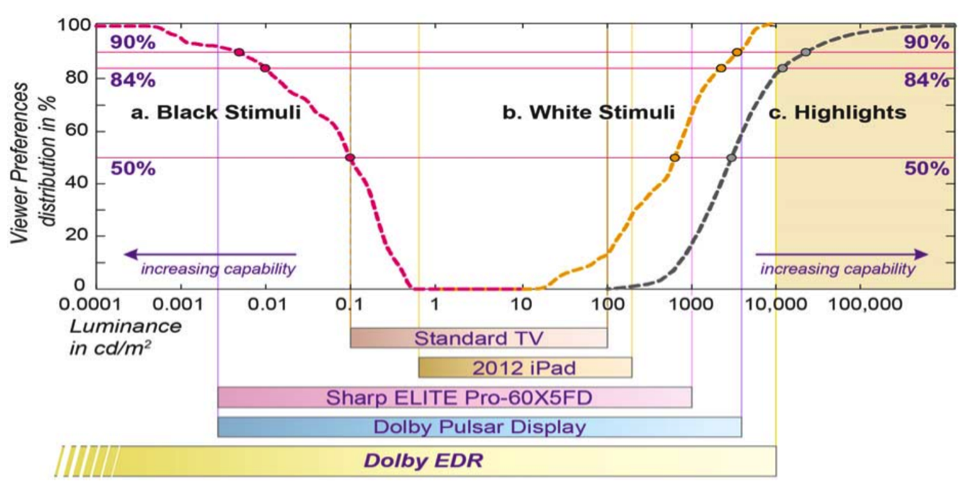First HDR/WCG Television Ecosystem Established

At the 2015 NAB Show, Dolby Laboratories announced that it had established the first video high dynamic range and wide color gamut television ecosystem, combining content creators with a content distributor and TV display manufacturer, all deployed around its proprietary video format called Dolby Vision.
The Ultra High-Definition (UHD) video space continues to develop its extensions beyond HDTV, along the multiple axes of greater spatial definition, higher luminance dynamic range (HDR), wider color gamut (WCG), and higher frame rate (HFR). Numerous proposals have been put forward in this environment by a number of organizations, and standards are under development in various SDOs, including ATSC (as part of the ATSC 3.0 next-generation TV standard) and SMPTE. To date, however, there have been no comprehensive decisions made on precisely what constitutes a complete UHDTV delivery format. The only real agreement to date has been on spatial resolution for first-generation UHD, at 3840 x 2160 pixels (“4K”).
Although a participant in these standardization processes, Dolby has simultaneously put forward its proprietary format, albeit in a limited manner, via the over-the-top (OTT) Internet TV environment. The partners in the ecosystem to date include Warner Bros. (which has developed a few items of feature-film content in the format), Walmart’s VUDU OTT service, and TV manufacturer Vizio. At the initial announcement on April 13, 2015, Vizio planned to offer Dolby Vision support on both HD and 4K televisions of up to 120 inch display size, although availability dates and prices have not yet been specified.
There have been hints that this initial consortium of players may expand, but even in its currently limited arrangement, the Dolby announcement is a shot across the bow to the standards development players, indicating that proprietary, end-to-end alliances are possible in the UHD space. This implies that if true de jure standards are not developed soon, there is risk that a number of de facto“standards” could emerge and dilute any effort for a singular industry format to attain critical mass around HDR and/or WCG. Thus even such a limited grouping as the current Dolby Vision initiative puts pressure on broader standards initiatives to accelerate their activities. Meanwhile, the process also may generate valuable learning for SDOs as to what elements of UHD appeal most strongly to consumers.
(Incidentally, in an attempt to avoid divergence and possible balkanization among UHD formats, two industry groups recently have been formed—the UHD Alliance and the UHD Forum. The former allies content creators with display manufacturers for the proper and uniform realization of producers’ intent, while the latter and more nascent group intends to coalesce common practices for distribution and transmission of UHD content.)
Technically, the Dolby Vision approach sets a dynamic range that extends the maximum luminance capability of the HDR display from its current level of 100 candela per square meter (cd/m2, generally referred to as “nits”) in television to 10,000 nits. (The latter extreme is expected to be used only for adding small highlights, while more typical bright picture elements might range around 1,000 nits.) Dolby cites subjective testing of viewers that it conducted in determining this range (see figure below), and although the current Vizio displays only reach 800 nits, the resulting images are noticeably improved to most viewers when compared with standard luminance displays. This had led many industry observers to the belief that HDR and WCG (and perhaps also HFR) may be more important than spatial resolution (4K) alone for broad adoption of UHDTV.

The Dolby Vision format also includes an adaptation of WCG tailored to its extended luminance range. Rather than simply adapting current practice in the electro-optical transfer function (EOTF), Dolby proposes a perceptually based quantization method (PQ), allowing what might require up to 15 bits for each video sample to be reduced to 12 bits, and still deliver perceptually effective HDR and WCG images.
Another key issue is backward compatibility. For example, given that new TV screens are required to display HDR content (even at HD resolutions), will the same content display properly on standard dynamic range (SDR) screens, or will two discrete versions of the content be required? Naturally, it would be preferred if a single content format could be developed that provides HDR quality to HDR-capable displays but still renders acceptable pictures to SDR displays, similar to how HD content is handled by SD displays today. Experts have noted, however, that such HDR-to-SDR compatibility and the management of multiple color spaces are more challenging than simply rescaling spatial resolution across multiple display types. Said another way, HDR and WCG are about the quality of pixels, not the quantity of them.
Although obviously quite active in the UHD space, Dolby is not alone, with substantial effort and prototype formats or hardware also being developed by Sony, Samsung, Technicolor, LG and others. And while not as mature as development in the spatial resolution area, it has become generally acknowledged that HDR and WCG (and possibly HFR) are important elements that should be included in any initial UHDTV delivery standard. Developers in these areas are therefore under pressure to bring their work to a point at which it can be considered for standardization, so developments like the Dolby Vision announcement can have significant impact upon the progress of next-generation TV standards like ATSC 3.0.

